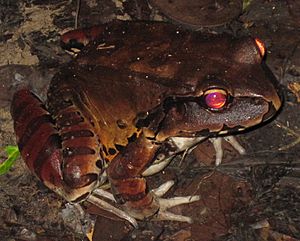Smoky jungle frog facts for kids
Quick facts for kids Smoky jungle frog |
|
|---|---|
 |
|
| Conservation status | |
| Scientific classification |
The smoky jungle frog (Leptodactylus pentadactylus) is a type of frog that belongs to the Leptodactylidae family. You can find these frogs in many South American countries, including Bolivia, Brazil, Colombia, Ecuador, French Guiana, and Peru. They also live in Costa Rica and Panama.
These frogs like to live in different wet places. Their homes include warm, wet tropical and subtropical moist broadleaf forests, swamps, and wet mountain forests. They also live near rivers, freshwater marshes, and even special ponds made for farming fish.
Contents
What Are They Called?
In the Kwaza language of Rondônia, Brazil, this frog is called huwa.
How Do They Look?
Smoky jungle frogs are big and strong. Male frogs are a little bigger than females. Males can grow up to about 18 centimeters (7 inches) long from their snout to their rear. Females can reach about 17.6 centimeters (6.9 inches).
Their bodies are sturdy, and they have a large head with a rounded snout. They also have a clear eardrum, called a tympanum. Their skin is smooth, and they have a noticeable fold of skin from their eye to their leg. Their fingers and toes are long and thin, without any webbing between them.
Male frogs that are ready to mate have very strong front legs. They also have one sharp, black spike on their inner thumb and two black spikes on each side of their chest.
Their back is usually tan or reddish-brown. They have wide, reddish-brown marks on their body between yellowish-tan folds of skin. Their legs are tan to reddish-brown with thin brown stripes. Their upper lip is tan with a brown edge and dark brown triangle spots. Their belly and back legs are cream-colored with bold dark brown or black patterns. Their eyes are a bronze color.
Where Do They Live?
These frogs live in low areas, below 1,200 meters (about 3,900 feet). They are found from Costa Rica down to the Pacific lowlands of Ecuador. You can also find them all across the Guianas and the northern two-thirds of the Amazon Basin in South America.
Their Home and Habitat
The smoky jungle frog mainly lives in tropical rainforests. However, they can also be found in drier forests and lower mountain forests.
How They Behave
These frogs are nocturnal, meaning they are active at night. During the day, they hide in burrows, under logs, or in leaf litter (fallen leaves and twigs).
If they feel threatened, they have ways to protect themselves. They can release a bad-smelling liquid from their skin. They also puff up their bodies with air and stand tall on all four legs to look bigger. If someone grabs them, these frogs often let out a loud, high-pitched scream.
What Do They Eat?
Young smoky jungle frogs eat small insects and other tiny creatures. But big adult frogs eat larger insects, other frogs, lizards, snakes, and even small birds and mammals like bats.
Baby frogs, called tadpoles, eat many different things. They eat plants, other tadpoles, and even the eggs of their own kind!
Reproduction and Life Cycle
Male frogs call out by themselves from the edges of ponds or slow parts of streams. Their call is a loud "whoorup" sound, repeated every five to ten seconds.
When a female frog is interested, the male grabs her tightly under her arms. He holds her with his strong forearms and the special spikes on his thumbs and chest.
They lay about 1,000 eggs in a large foam nest. The male uses his back legs to mix air, water, eggs, and special liquids into this foamy nest. The nest is usually made in a dip in the ground right next to water.
The eggs hatch in about two to three days. When it rains, the nest area floods, and the tadpoles swim into the pond or slow stream. They grow quickly, and they change into frogs about four weeks after hatching.
Tadpoles can grow up to about 83 millimeters (3.3 inches) long. Their bodies are oval-shaped with a rounded snout. Their large eyes look up and to the sides. Their mouth is near the front and has finely toothed jaws. It also has rows of tiny teeth-like structures. The tadpole's body and tail muscles are brown.
Toxicity
The skin of the smoky jungle frog has a special substance called leptoxin. Scientists are still learning what this substance does.
See also
 In Spanish: Leptodactylus pentadactylus para niños
In Spanish: Leptodactylus pentadactylus para niños



